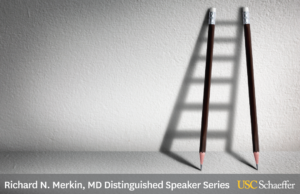Editor’s note: This story was first published by STAT on October 14, 2021.
Body counts appear to support the common perception that Covid-19 does its worst damage among the old and vulnerable. But body counts mask another reality, and focusing on them is skewing policy decisions and individual choices.
There’s no question that deaths were most common among old and vulnerable individuals early in the pandemic. Some politicians and academics have used death rates to conclude that the pandemic’s toll has been largely confined to the elderly and sick, and that widespread mitigation measures such as mask and vaccine mandates are unjustified.
We looked at Covid-related deaths through a different lens — years of life lost — which revealed a very different picture about the burden of illness than deaths alone.
Sign up for Schaeffer Center news
In a recent study, we and our colleagues Hanke Heun-Johnson and Bryan Tysinger showed that the Covid-19 pandemic has stolen an enormous amount of life from young and old alike. Because of the pandemic, Americans will celebrate at least 9 million fewer birthdays in the years to come, and more than half of them were lost to people under age 65.
While every premature death brings tragedy to a family, deaths among younger and middle-aged adults steal more years of life. For example, 80-year-olds who died from the pandemic lost about 7.7 years of life on average, but 40-year-olds who died lost about 36 years on average. When we accounted for the number of years lived in good health, rather than simply the number of years lived, the gap between young and old widened even further: 40-year-olds who died lost more than five times the number of healthy years as did 80-year-olds.
The focus on deaths affecting mainly the elderly is unfortunate because it likely created a false sense of security among the young. That has led to lower vaccination rates, resistance to preventive measures, and now, tragically, growing death rates. According to the Centers for Disease Control and Prevention (CDC), the number of people in their 30s who died of the virus in August was about 50% higher than the number who died in January, the month with the highest number of deaths recorded in the U.S.
The notion that those killed by Covid-19 would have died soon anyway is also false. According to our study, the average Covid-19 death among those aged 45 to 54 years resulted in the loss of 29 years of life, slightly below life expectancy for that age group but still an enormous loss of life. In fact, we estimated that 40% of the 740,000 people who died prematurely in the first year of the pandemic would have had average or above-average life expectancies had the pandemic not occurred.
Part of the reason that the pandemic has stolen so much life is that Covid weaponizes chronic health conditions that would not otherwise shorten life expectancy by much. The case of obesity, a major risk factor for Covid-19 death, helps illustrate. Even living with obesity, a 40-year-old can expect to live for more than 30 years. Those years evaporate with a Covid-19 death.
Adding up years of lost life may seem like a soulless exercise. But these years reflect a very real human toll, of loved ones missing from millions of Thanksgiving dinner tables and family milestones. Years of life lost also have important policy implications, because those forgone years represent enormous losses to families, businesses, and society at large. While the economic value of one year spent in good health remains a source of debate, $150,000 is frequently used as a rule of thumb by policymakers. After adjusting for time spent in good health and doing the math, the total cost of life-years lost from the first year of the pandemic alone approaches $1 trillion, even before accounting for all the other non-fatal consequences of Covid-19, such as long-term symptoms, missed work, caregiver burden, and the like.
Policymakers ignore years of life lost by younger Americans at their peril. Focusing quarantine and mitigation efforts exclusively on those near the end of their lives — as, for example, Florida did — overlooked a substantial portion of those who suffered with and died from Covid-19.
As other studies have shown, our analysis found that Covid-19 hit minority communities especially hard, producing large racial and ethnic disparities in the loss of life. Across all ages, men and women from Black and Hispanic communities lost years of life at over twice the rate of white men and women. The disparity was largest among Black men ages 25 to 64, who lost life-years at three times the rate of their white peers.
Our study, which was performed at the USC Schaeffer Center for Health Policy & Economics, adds to the body of research about the burden of Covid-19 on American lives. It drew on data from the CDC and the Centers for Medicare and Medicaid Services to examine Covid deaths during the first full year of the pandemic in the U.S., from March 2020 to March 2021. The Schaeffer Center’s Future Elderly Model and Future Adult Model were employed to account for a broad array of risk factors, including chronic illness, body weight, health behavior, age, sex, race, and ethnicity, to estimate the years lost by those who died.
The study ended before the Delta variant of SARS-CoV-2 struck. There is every reason to believe the new wave it helped generate has shifted the burden of the disease even more to younger Americans, who remain less enthusiastic about vaccination than older adults. The early campaigns to urge younger people to get vaccinated stressed how doing so would protect others, but our evidence makes clear that — even for younger, healthier groups — the life-years you save by getting vaccinated could be your own.



